View from Sapsucker Woods: A Deal to Save Tejon Ranch, California
By John Fitzpatrick, director of the Cornell Lab July 15, 2008
Some of the most biologically encompassing conservation projects require difficult compromises to reconcile the competing demands of disparate stakeholders, in a process recalling the sausage factory: we appreciate the product, but prefer not to watch the messy process of making it. This is not science, it is human communication, but in the best such negotiations scientific integrity takes center stage, guiding the outcome while economic, political, social, and philosophical forces vie to influence the result.
A superb example of this process recently was announced in California at a ceremony featuring Governor Schwarzenegger and several major conservation organizations. At stake was the fate of Tejon Ranch, the largest and most biologically diverse piece of contiguous private property in California. For two years, representatives of five conservation organizations and the Tejon Ranch Company met confidentially (with science support from the Conservation Biology Institute and South Coast Wildlands) to hammer out a deal everyone knew would be controversial. The challenge: find a way to preserve the unparalleled natural beauty and rich biological diversity of this 269,000-acre (430-square mile) ranch in light of the company’s plans to build thousands of homes, plus hotels, condominiums, golf courses, and commercial developments in this once-pristine wilderness.
The precedent-setting deal commits the Tejon Ranch Company to a sweeping array of conservation measures covering up to 90 percent of the ranch, including conservation easements and dedicated open space on 178,000 acres, an option to purchase easements on an additional 62,000 acres, and immediate management actions to protect existing conservation values of these 240,000 acres. The company will provide substantial funding to establish an independent Tejon Ranch Conservancy to manage and restore the landscape, plus a permanent funding source through a transfer tax on the sales of lots and homes. Thirty-seven miles of the Pacific Crest Trail will be reconfigured to allow hiking across the ranch, a plan for public access will be developed, and the parties to the agreement will work to establish a state park. In exchange, the conservation organizations (Audubon California, Natural Resources Defense Council, Sierra Club, Planning and Conservation League, and Endangered Habitats League) agreed not to oppose the landowner’s efforts to obtain development permits over which these organizations would otherwise have gone to war.
Critics immediately slammed the agreement, citing “poison pill” provisions and “greenlights [for a] a behemoth city on the last wild edge of Los Angeles County.” The presence of a reintroduced population of endangered California Condors, and prior designation of the ranch as “critical condor habitat,” made the agreement especially controversial. However, Tejon Ranch Company did engage three of the world’s foremost condor experts in the negotiations, and then agreed to numerous provisions to ensure that most condor habitat on the ranch would remain wild and safe for condors.
The Tejon Ranch Company, its development partners, and the conservationists recognized the high stakes and chose to negotiate in good faith, listening and communicating with science at the forefront. The developers sought a predictable and positive outcome by engaging directly with conservation organizations that would otherwise legally challenge their projects. The conservationists recognized a key opportunity to negotiate a comprehensive vision with a single landowner, rather than wait until piecemeal sales led to years of expensive legal battles against numerous development projects, under uncertain future regulatory conditions. Negotiations produced true landscape-scale conservation: long-term protection for an immense and ecologically crucial mosaic of ecosystems, at the expense of significant but geographically circumscribed developments along the Interstate 5 corridor (which still must undergo standard regulatory review).
I can only imagine what it must have been like inside this sausage factory, but as a conservation scientist I applaud all those who recognized the non-scientific realities of accomplishing such a large-scale agreement. Would that more such efforts be launched, in place of courtroom brawls.
All About Birds
is a free resource
Available for everyone,
funded by donors like you
American Kestrel by Blair Dudeck / Macaulay Library




